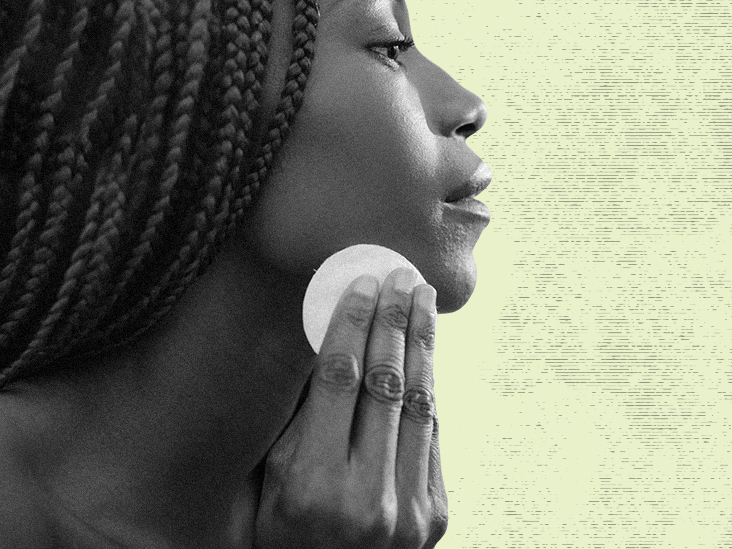For many years, people have been using witch hazel for its anti-inflammatory and astringent properties. Some people may also use the plant for acne.
Witch hazel is a plant that is native to North America. Some
Acne is a chronic skin condition that causes symptoms
This article provides an overview of witch hazel and explains how it may reduce acne breakouts.
Witch hazel comes from the North American witch hazel plant, also known as the Hamamelis virginiana shrub. It is a natural liquid extract with
Witch hazel can soothe irritated skin. It can gently remove oil and sebum from the skin’s surface, making it a suitable ingredient for acne products.
The Food and Drug Administration (FDA) has approved the use of witch hazel as a topical over-the-counter medicine. Witch hazel is free of environmental pollutants, unnatural fragrances, and contaminants.
Acne is an inflammatory skin condition, and witch hazel has anti-inflammatory properties. This means that witch hazel may decrease skin irritation due to acne.
Witch hazel also contains tannins, which are natural chemicals that can kill bacteria on the skin and prevent new bacteria growth.
Witch hazel can
Witch hazel extract can mix with water or alcohol to form witch hazel water or distilled witch hazel extract. This mixture contains polyphenols and tannins.
The tannins in witch hazel work as a natural astringent, removing excess oil from the skin. It can reduce shine and control acne. In fact, many topical acne treatments include witch hazel.
Before using witch hazel for acne, a person should test the product on a small patch of skin to check for a reaction. Witch hazel can irritate the skin in combination with harsher ingredients, such as alpha hydroxy acids. Alcohol-free witch hazel products are gentler on the skin.
Witch hazel works well as a toner for cleaning the skin. A person can also apply witch hazel creams as spot treatments for pimples.
Witch hazel has anti-inflammatory properties that can calm and soothe irritated skin. Some people claim that it can reduce swelling and speed up the healing of sores and infections.
People may use witch hazel to treat several different conditions and ailments, including:
People should test witch hazel on a small skin patch and monitor the area for side effects before using it on a regular basis. Some people may have allergic reactions to witch hazel or experience minor side effects, such as redness and itching.
Due to its astringent properties, frequent witch hazel use can dry and irritate the skin. People with dry or sensitive skin should use witch hazel sparingly or avoid it entirely. Dry and irritated skin can start to produce more oil, which can lead to more acne breakouts.
People should not ingest witch hazel, which may cause nausea, vomiting, or liver damage.
For treating acne on oily skin, people can use toners with salicylic acid or glycolic acid instead of witch hazel. These ingredients help exfoliate the skin and remove dirt and dead skin cells.
Those with drier skin may want to consider using products with glycerin or hyaluronic acid instead of witch hazel.
Generally, witch hazel for acne works best when in combination with other acne treatments.
Any person with moderate to severe acne may want to see a dermatologist for recommendations and prescriptions to treat their acne.
Common questions and answers about witch hazel for acne include:
Yes, research suggests that the anti-inflammatory and astringent properties in witch hazel can minimize acne breakouts. The anti-inflammatory properties calm the skin, while the astringent properties reduce excessoil on the skin that can lead to clogged pores and breakouts.
Witch hazel can also disinfect the skin of acne-causing bacteria.
Witch hazel can cause dryness and irritation if people use it in large quantities. If this happens, the irritated skin may react by producing more oil. Excess oil can clog pores and cause breakouts.
Current research does not show that witch hazel can reduce the appearance of acne scars. However, it can calm the inflammation and redness that acne causes.
Witch hazel is a natural medicinal product with anti-inflammatory and astringent properties that benefit the skin. People use it for acne and other skin conditions, such as sunburn and insect bites.
Some people successfully use witch hazel to treat their acne. Its anti-inflammatory properties calm the swelling and reduce acne on the skin.
It is generally safe, but people should test witch hazel on a small patch of skin before applying it to larger areas. Excessive use of witch hazel can dry and irritate the skin.
Last medically reviewed on March 27, 2022
6 sourcescollapsed
Witch hazel has anti-inflammatory and astringent properties, so many people use it at home for common complaints, such as acne or varicose veins…
Acne forms pimples, also known as zits or spots, and can be persistent and difficult to control. There are however safe and effective treatments…
How beneficial is salicylic acid for acne? Read on to learn what salicylic acid is, how it works to treat acne, and whether it is safe and effective.
Vitamin A may help treat acne by reducing inflammation, cell damage, and redness. Learn more about its effectiveness and uses in this article.
Acne patches may help treat and control pimples and other symptoms of acne. Read on for some of the best options for a person to consider.
OUR BRANDS
